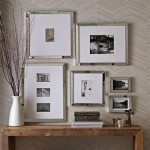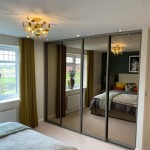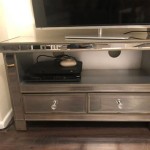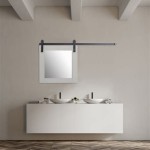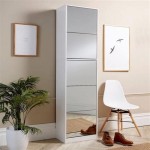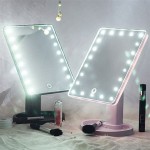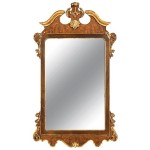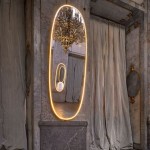Mirrored Wall Decorating Ideas: Enhancing Space and Style
Mirrored walls have long been utilized in interior design to create a sense of spaciousness and amplify light within a room. The reflective properties of mirrors can visually expand a confined area, making it appear larger and more inviting. Beyond their practical applications, mirrored walls also offer a diverse range of aesthetic possibilities, allowing for the integration of various design styles and the creation of unique focal points.
This article explores several mirrored wall decorating ideas, outlining how to effectively incorporate them into various spaces and achieve different design objectives. Considerations will include the types of mirrors available, installation techniques, and the impact of surrounding elements on the overall aesthetic.
Strategic Placement for Maximum Impact
The strategic placement of a mirrored wall is crucial to maximizing its effect on the perceived size and brightness of a room. Before installation, careful consideration should be given to the room's natural light sources, existing architectural features, and the desired focal points. Incorrect placement can lead to unwanted reflections or a feeling of disorientation, negating the benefits of the mirrored wall.
A mirrored wall positioned opposite a window, for example, can effectively double the amount of natural light entering the room. This is particularly beneficial in spaces with limited access to sunlight. Furthermore, placing a mirrored wall along a narrow hallway can visually widen the space, preventing a claustrophobic feeling. In living rooms or bedrooms, a mirrored wall can be used to reflect a curated display of artwork or furniture, creating a sense of depth and visual interest.
Conversely, avoid placing mirrored walls where they will reflect cluttered areas or unattractive views. Doing so will only amplify the visual noise and detract from the overall aesthetic. Instead, focus on reflecting areas that are well-organized and visually appealing. It is also important to consider the height of the mirrored wall. A full-height mirror will create the illusion of a taller ceiling, while a partial wall mirror can define a specific zone or highlight a particular feature.
Types of Mirrors and Their Applications
The market offers a wide variety of mirrors, each with its own unique characteristics and applications. The selection of the appropriate type of mirror is essential to achieving the desired aesthetic and functional goals. Standard clear mirrors are the most common and versatile, providing a true reflection and maximizing light amplification. However, other options, such as tinted mirrors, antique mirrors, and fragmented mirrors, can be used to achieve more specialized effects.
Tinted mirrors, such as bronze or gray mirrors, can add warmth and sophistication to a space. These mirrors tend to reflect less light than clear mirrors, but they can create a more subdued and elegant atmosphere. Antique mirrors, with their distressed and aged appearance, can add character and vintage charm to a room. These mirrors are often used in spaces with a rustic or traditional design aesthetic. Fragmented mirrors, composed of multiple smaller mirror pieces, can create a mosaic-like effect and add a touch of modern artistry to a space.
Beyond the aesthetic considerations, it is also important to consider the thickness and quality of the mirror. Thicker mirrors tend to be more durable and less prone to distortion. High-quality mirrors will provide a clearer and more accurate reflection. For larger mirrored walls, it is often recommended to use tempered glass mirrors, which are more resistant to shattering.
Framing and Edging Options
The way a mirrored wall is framed or edged can significantly impact its overall aesthetic. Frameless mirrors offer a clean and contemporary look, allowing the reflective surface to seamlessly blend into the surrounding environment. Framed mirrors, on the other hand, can add a touch of elegance and sophistication, and can be used to complement the existing decor.
When choosing a frame, consider the material, color, and style. Wooden frames can add warmth and natural texture to a space, while metal frames can create a more modern and industrial look. The color of the frame should complement the surrounding walls and furniture. A contrasting frame can create a bold statement, while a matching frame can create a more cohesive and understated look.
Edge treatments can also enhance the aesthetic of a mirrored wall. Beveled edges add a touch of elegance and sophistication, while polished edges create a clean and contemporary look. For frameless mirrors, edge treatments are particularly important, as they can protect the edges from chipping and damage. Additionally, consider adding LED strip lighting around the perimeter of the mirror. This can create a soft and ambient glow, enhancing the reflective properties of the mirror and adding a touch of drama to the space.
Integrating Mirrored Walls into Different Design Styles
Mirrored walls can be seamlessly integrated into a variety of design styles, from minimalist to maximalist, depending on the specific application and surrounding decor. In minimalist spaces, a large, frameless mirrored wall can enhance the clean lines and spacious feel, further emphasizing the simplicity of the design. The reflection of essential elements, such as a statement piece of furniture or a curated collection of artwork, can amplify their impact without adding excessive visual clutter.
For more traditional or maximalist spaces, mirrored walls can be used to add a touch of glamour and reflect ornate details. An antique mirror with an elaborate frame can complement the richness of the surrounding decor, creating a sense of historical depth and opulence. In bohemian-inspired spaces, a fragmented mirror or a collection of smaller, individually framed mirrors can add a touch of eclectic charm and reflect the vibrant colors and textures of the surrounding textiles and accessories.
In contemporary spaces, mirrored walls can be used to create a sense of fluidity and movement. A curved mirrored wall or a mirrored wall with geometric patterns can add a touch of modern artistry and reflect the sleek lines and minimalist aesthetic of the space. The key to successfully integrating a mirrored wall into any design style is to carefully consider the proportions, materials, and finishes of the mirror and its surrounding elements, ensuring that they complement each other harmoniously.
Addressing Potential Challenges and Considerations
While mirrored walls offer numerous aesthetic and functional benefits, there are also potential challenges and considerations that should be addressed before installation. One common concern is the potential for glare, particularly in rooms with direct sunlight. To mitigate this issue, consider using tinted mirrors or strategically placing the mirrored wall away from direct sunlight. Window treatments, such as blinds or curtains, can also be used to control the amount of light entering the room.
Another consideration is the maintenance of mirrored walls. Mirrors can easily accumulate dust, fingerprints, and watermarks, requiring regular cleaning. Use a soft cloth and a gentle glass cleaner to avoid scratching or damaging the mirror surface. For larger mirrored walls, consider hiring a professional cleaning service to ensure a thorough and streak-free finish. Furthermore, the installation of a mirrored wall can be a complex process, particularly for larger or custom-designed mirrors. It is often recommended to hire a professional installer to ensure that the mirror is properly secured and aligned.
Finally, consider the psychological impact of a mirrored wall. Some individuals may find the constant reflection of themselves and their surroundings to be distracting or unsettling. To mitigate this, consider using smaller mirrored panels or fragmenting the mirrored surface to break up the reflection. Strategic placement and careful consideration of the surrounding elements can also help to minimize any potential negative psychological effects.

Mirror Decoration For Home 15 Ideas To Decorate With Mirrors

10 Startling Wall Mirror Decor Ideas That You Must See Today

100 Must See Wall Mirror Ideas For Your Home Decor

25 Wall Mirror Decorating Ideas That Will Enhance Your Home Decor

Luxury House House8 Instagram Kuvat Ja T Interior Wall Design Hall Decor Entryway

5 Extraordinary Wall Mirror Ideas To Adorn Your Home

10 Ideas For Decorating With Mirrors Stance Studies On The Family Living Room Decor Wall

Mirror Decoration For Home 15 Ideas To Decorate With Mirrors

Mirror 5 Decorative Wall Ideas To Add Dimension Your Home

7 Ways To Decorate With Mirrors Thistlewood Farm
